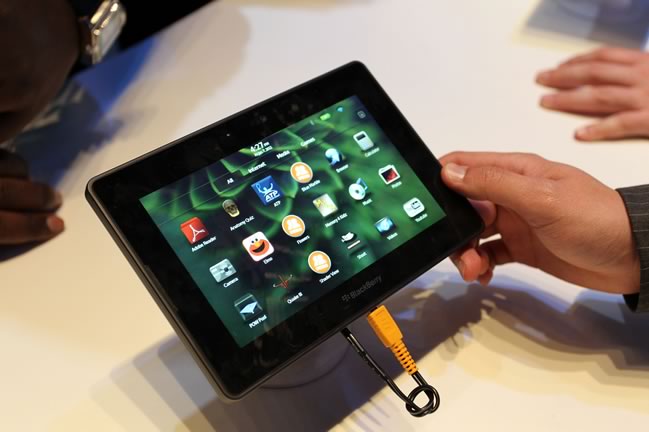Five years ago, launching a decent streaming platform took millions. Now? A teenager with a laptop can build something that reaches millions. That shift…
The BlackBerry PlayBook: Like dating someone with a drinking problem

Living with The BlackBerry PlayBook is like dating someone with a drinking problem. When you first meet, things are great. She seems fun. A lot of fun.
I mean fun, like she can drink you under the table, and sometimes when you’re under it, she’ll be dancing on top of it. After a while though, the violent mood swings and the smell of whiskey on her breath at noon on a Monday isn’t endearing anymore. She’s a hot mess, and you’re sort of over it.
 And yet, when you’re holding her hair while she vomits onto the sidewalk, you can’t help but love her. You see through the dents in her car, and the angry looks on her neighbour’s faces — it’s the second time this week that tire tracks lead from their prize petunias to her garage door — because she’s trying. She’s seeing a psychologist, attending meetings, and she promises to get better.
And yet, when you’re holding her hair while she vomits onto the sidewalk, you can’t help but love her. You see through the dents in her car, and the angry looks on her neighbour’s faces — it’s the second time this week that tire tracks lead from their prize petunias to her garage door — because she’s trying. She’s seeing a psychologist, attending meetings, and she promises to get better.
The PlayBook has been wooing me for the last month of my life, and our extended courtship has been a roller coaster ride with glorious peaks, and gloomy lows, and yet; in the end, I’m left with a sense of optimism. If only it could kick its drinking problem and penchant for all night bingers, I could bring it home to meet the parents.
She’s got potential
If I buy a WiFi only tablet, it seems like a bonus to have access to unlimited data for web browsing and email when I’m not home, thanks to BlackBerry Bridge. I just connect the PlayBook to my BlackBerry and suddenly my email, web browsing, calendar and BBM experience is amplified.
As a BlackBerry owner, I scratch my head when tech pundits slam the PlayBook for the lack of a native email client. The client is native*. It’s compiled and runs on the PlayBook. It’s just pulling the data from my phone.
I understand the omission of an SD slot on the PlayBook because my BlackBerry has an SD card which I can browse using Bridge Files**.
As a BlackBerry user, I’ve never been spoiled with hundreds of thousands of apps. I’ve been happy with apps from the headline acts and so the PlayBook’s lack of initial app selection isn’t a deal-breaker for me. Even so, with the lack of a native Twitter client and apps in general (due to slow developer uptake and delayed BlackBerry/Android app players), the PlayBook redeems itself through its browser. Flash-loving and built on WebKit, it’s the full web in your hands. It’s a liberating feeling.
The PlayBook is indeed my “BlackBerry amplified”. A panacea of sorts for the shortcomings of my phone.
When I use BlackBerry Bridge, suddenly my phone’s face becomes a suave, handsome 7-inch rectangle with bullet proof build quality that feels amazing in hand. Its ARM based 1GHz OMAP4430 dual-core processor from Texas Instruments can easily decode 1080p video and split output to a TV via HDMI and to its gorgeous, on-device, 1024×600 resolution, 170 ppi display… simultaneously.
When Bridged, my Web browsing experience gets a shot of steroids. As a BlackBerry user, I understand why RIM is making such a big deal about the browser. It’s the best browser RIM has ever produced, and certainly trumps anything I’ve ever used on a BlackBerry. I look at it and it makes me excited about QNX-based phones.
Sans the benefits of BlackBerry Bridge, the PlayBook performs like an Ethiopian long distance runner, and doesn’t even break a sweat. If it wasn’t for the back of the PlayBook heating up slightly under heavy load, you’d never be able to tell that its under any kind of strain as the UI experience remains smooth, and true multitasking is effortless with the added benefit of 1GHz of RAM.
While we’re on the UI, it is the single most enjoyable experience I’ve had on a tablet to date. Nothing that Apple or Google produced so far comes close to the experience on the PlayBook. Arguably taking cues from WebOS, the PlayBook’s zero-button solution uses simple gestures for navigation. It felt natural within a few of minutes, so natural in fact, that I’ve found myself accidentally attempting these bezel-originating gestures on other devices.
Finally, it also helps to know that the PlayBook has Integrated POWERVR SGX540 graphics, which means OpenGL, which means 3D gaming. It even has Rovio’s blessing.
She’s not perfect
The PlayBook has all the hallmarks of something that should be spectacular, but having been written off by the majority of the tech press, has become dangerously underrated.
Beyond the BlackBerry crowd, the PlayBook is an awkward proposition for consumers. RIM’s attempt at depicting the PlayBook as a tablet for everyone meant that the media placed it head-to-head with the people’s computer, the iPad. That was a mistake.
If RIM was serious about casting its net as wide as possible, it feels irresponsible to not at least bundle the PlayBook with a BlackBerry.
I’m patient enough to know that the PlayBook will experience an eventual efflorescence as the software improves to run on top of the solid hardware, but not everyone is. Even internally, RIM appears to be divided on the PlayBook’s software. In an open letter written to RIM’s management the author writes: “Even PlayBook, with all its glorious power, looks like a Fisher Price toy with its Adobe AIR/Flash apps”. What average consumer wants to spend money on a tablet with promises about future, when the iPad already delivers and is cheaper?
The iPad came out of nowhere. It created an illusion of a tablet market, when really, it was simply an iPad market. It’s difficult to do what the iPad does, and the reality has started to sink in for competitors, who have reportedly slowed down tablet production by as much as 10% since March this year.
Unfortunately competing with the iPad means coming out of the gate at full tilt, with a canister of nitrous oxide.
Let me explain. I’m kicking back with the PlayBook after a long day. It’s connected to WiFi, and I’m Bridged to my phone — which is also connected to WiFi.
 I start streaming a full screen, 1080p video from YouTube, and it feels like the pixels of the WSVGA display are making love to my retinas. I marvel at the smoothness of the video and the sound from the stereo speakers splash down my ear canals like chocolate milk. I swipe up, and the video effortlessly moves up to the multitasking area, revealing the app selection screen.
I start streaming a full screen, 1080p video from YouTube, and it feels like the pixels of the WSVGA display are making love to my retinas. I marvel at the smoothness of the video and the sound from the stereo speakers splash down my ear canals like chocolate milk. I swipe up, and the video effortlessly moves up to the multitasking area, revealing the app selection screen.
I open the native email client*, and start browsing the messages on my BlackBerry. I even reply to a few while the music video’s audio keeps playing in the background. I swipe up and watch it go sit next to the YouTube video — still playing in its minimized form — in the multitasking tray.
I open Doodle Blast, my latest gaming obsession on the PlayBook. After playing a few rounds, my thoughts wander, and I remember SketchBook, the app designed by The Astonishing Tribe, the design firm RIM acquired in December last year. It really is a beautiful app, and I daydream about the future user interfaces of BlackBerry devices.
My dream is short-lived when the PlayBook suddenly freezes. After a few seconds it shuts down. I try to turn it back on, but nothing happens. After a few minutes I start to freak out a little. I start Googling for similar experiences, but find nothing. I Google “PlayBook hardware reset” and find some frantic forum posts and replies that says something about pressing the media buttons. I try every combination, my fingers playing a game of twister. I put the PlayBook down and as I stare at it in dread. Minutes pass and after a while I realise that I’ve stopped breathing. Suddenly the PlayBook comes back to life, and I gasp for air.
Something else that worries me slightly is the PlayBook’s browser. With so much focus on it, you almost expect it to be perfect, but sadly it isn’t. The browser does a good job of rendering Flash, but it feels a bit Dr. Jekyll and Mr. Hyde. On one hand it eats Flash-heavy site like We Choose The Moon for breakfast, and yet fails at times with Flash compnents on Google’s Music Beta. I’ve also noticed that the Flash implementation on the PlayBook doesn’t support running Flash objects simultaneously in multiple tabs. Instead, objects that lose focus when switching tabs will pause, and then resume when you switch back.
In general, since the PlayBook is still relatively new, some web sites don’t quite know what to make of it. Rdio simply blocks me, and it’s clear that Google will need to do some work on Docs to remedy the disappointing experience on the PlayBook. I mention Google Docs because the native Word To Go text editor is beautiful, yet lacking; good for editing existing documents, but not good for creating new ones — you can’t embed pictures, tables or even run a spell check.
Finally, when Bridged, your user agent string appears to be that of your BlackBerry phone’s browser, and it’s annoying to get served up mobile versions of sites when you’re viewing them on a tablet.
Beyond the 12-step program
Ultimately despite its imperfections, the PlayBook has won me over and it will definitely leave a void in my life when I have to return the review unit. It’s not for everyone, but if you love your BlackBerry and you’re looking for the spaghetti to your meatballs, the PlayBook won’t disappoint.
It’s mostly software problems, and with a few updates and some shiny new apps, the PlayBook could be spectacular. It has the hardware foundation, RIM just has to start delivering on its promises, apply some polish, and keep it together.
* Ed: There is some terminology creep here. A native email client is one compiled and written for the device, which arguably the PlayBook has. The big criticism of BlackBerry is that its email client can’t send and receive mail from any POP or IMAP mail server – to do this using BlackBerry Mail, you have to make it pull mail from your servers to deliver to you. Many don’t want their mail anywhere near BB’s mail servers. Privacy. Redundancy. Choice.
** Ed: Unless you see the omission of this as a universal heresy on the grounds that to put a micro-SD card reader in would cost a trivial amount, but allow you to freely transfer files, as well as a cheap way to add storage capacity.


